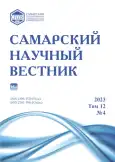Характер растительного покрова и структура сообществ мелких млекопитающих (на примере г. Нижнего Новгорода)
- Авторы: Борякова Е.Е.1
-
Учреждения:
- Национальный исследовательский Нижегородский государственный университет им. Н.И. Лобачевского
- Выпуск: Том 12, № 4 (2023)
- Страницы: 15-22
- Раздел: Биологические науки
- URL: https://journals.rcsi.science/2309-4370/article/view/260629
- DOI: https://doi.org/10.55355/snv2023124102
- ID: 260629
Цитировать
Полный текст
Аннотация
Изучено пространственное распределение видов рода Apodemus (желтогорлой, полевой, малой лесной мышей) на примере ООПТ «Дубрава Ботанического сада Университета» г. Н. Новгорода. Исследовано 12 растительных ассоциаций, носящих неморальный характер и представляющих собой производные коренного типа растительности. Условия среды, оцененные методом фитоиндикации по Элленбергу, влияют на распределение мелких млекопитающих в пространстве опосредованно. Более значим характер растительного покрова. При увеличении проективного покрытия возрастает численность как малой лесной, так и полевой мышей. Стратегия вида Apodemus agrarius оказывается сходной с таковой Apodemus uralensis – вида, проявляющего в условиях исследованного ООПТ черты стенобионтности. В то же время незначительная антропогенная нагрузка, маркером которой является присутствие вида-рудерала Urtica dioica, приводит к увеличению мозаичности растительного покрова, что положительно отражается на численности этих видов мелких млекопитающих. Умеренное возрастание индекса доминирования Бергера–Паркера для растительного покрова положительно сопряжено с приуроченностью микромаммалий. Кроме того, в условиях рекреационной зоны нагорной части г. Н. Новгорода Apodemus agrarius оказывает предпочтение участкам старовозрастного широколиственного леса, не проявляя черт антропофильности.
Ключевые слова
Полный текст
Открыть статью на сайте журналаОб авторах
Елена Евгеньевна Борякова
Национальный исследовательский Нижегородский государственный университет им. Н.И. Лобачевского
Автор, ответственный за переписку.
Email: boryakova@mail.ru
кандидат биологических наук, доцент кафедры ботаники и зоологии
Россия, г. Нижний НовгородСписок литературы
- Черноусова Н.Ф., Толкачев О.В. Сообщества мелких млекопитающих лесных участков в условиях рекреационного и аэротехногенного воздействия городской среды // Вестник КрасГАУ. 2011. № 10. С. 145–150.
- Лукина Е.В., Баканина Ф.М. Памятники природы г. Нижнего Новгорода. Нижний Новгород, 1997. 142 с.
- Мининзон И.Л. Флора Нижнего Новгорода. Нижний Новгород, 2007. 104 с.
- Новиков Г.А. Полевые исследования экологии наземных позвоночных животных. Л., 1949. 602 с.
- Карасева Е.В., Телицына А.Ю. Методы изучения грызунов в полевых условиях. М., 1996. 226 с.
- Боряков И.В., Воротников В.П., Борякова Е.Е. Использование информационных технологий для ординации фитоценариев и обработки геоботанических данных // Ботанический журнал. 2005. Т. 90, № 1. С. 95–104.
- Дмитриев А.И., Залозных Д.В., Заморева Ж.А. Мелкие млекопитающие Нижегородской области // Наземные и водные экосистемы: межвуз. сб. науч. тр. Нижний Новгород, 1999. 28 с.
- Заморева Ж.А. Эколого-популяционный анализ мелких млекопитающих крупного города на примере Нижнего Новгорода: дис. … канд. биол. наук. Нижний Новгород, 2005. 151 с.
- Дмитриев А.И. Особенности распределения мелких млекопитающих на территории Нижнего Новгорода // Westbio. 2001. № 1. С. 2–5.
- Полякова Н.В. Антропогенная нагрузка на фитоценозы в агроэкосистемах пригородной зоны: автореф. дис. … канд. с/х. наук. Воронеж, 2004. 28 с.
- Жигарев И.А. Мелкие млекопитающие рекреационных и естественных лесов Подмосковья (популяционный аспект): монография. М., 2004. 232 с.
- Жигарев И.А. Изменение плотности населения мышевидных грызунов под влиянием рекреационного пресса на юге Подмосковья // Зоологический журнал. 1993. Т. 72, вып. 12. С. 117–137.
- Жигарев И.А. Организация и устойчивость рекреационных сообществ (на примере мелких млекопитающих): автореф. дис. … д-ра биол. наук. М., 2006. 48 с.
- Чернышев Н.В., Шварц Е.А., Жигарев И.А., Попов И.Ю. Материалы к характеристике роли мелких млекопитающих в экосистемах ельников – кисличников Валдая // Структура и функционирование экосистем южной тайги Валдая. М., 1986. С. 269–285.
- Шаталова С.П., Жигарев И.А. Влияние рекреации на население мьппевидных грызунов избранных биотопов юга Подмосковья // Четвертый съезд Всесоюз. териол. об-ва: тез. докл. Т. 1. М., 1986. С. 379–380.
- Жигарев И.А. Влияние рекреации на размножение и смертность грызунов в условиях южного Подмосковья // Зоологический журнал. 1997. Т. 76, № 2. С. 212–223.
- Алпатов В.В., Жигарев И.А. Влияние рекреации на население мелких грызунов в исследования в наукоградах Московской области. Черноголовка, 2001. С. 87–88.
- Карасева Е.В., Телицына А.Ю., Самойлов Б.Л. Млекопитающие Москвы в прошлом и настоящем. М.: Наука, 1999. 244 с.
- Карасева Е.В., Тихонова Г.Н., Степанова Н.В. Мелкие млекопитающие незастроенных участков города Москвы // Бюл. МОИП. Отд. Биол. 1990. Т. 95, вып. 2. С. 32–44.
- Гашев С.Н. Млекопитающие в системе экологического мониторинга на примере Тюменской области. Тюмень, 2000. 220 с.
- Истомин А.В. Динамика популяций и сообществ мелких млекопитающихкак показатель состояния лесных экосистем (на примере Каспийско-Балтийского водораздела): автореф. дис. … д-ра биол. наук. М., 2009. 48 с.
- Strohbach M.W., Burgess P.J., Clark J.H., Masey N., Morris J. Using small mammals as indicators of sustainable land use: A case study on farms in Southwest England // Agriculture, Ecosystems & Environment. 2008. Vol. 124, iss. 1–2. P. 56–62.
- Barquín J., Vilches A., Lobo J.M., Morales M.B. Effects of landscape structure on small mammal assemblages in a Mediterranean semiarid agroecosystem // Agriculture, Ecosystems & Environment. 2008. Vol. 126, iss. 1–2. P. 43–50.
- Băncilă R.I., Cogălniceanu D. Yellow-necked mouse (Apodemus flavicollis) habitat selection in a mixed deciduous forest in the Eastern Carpathians // North-Western Journal of Zoology. 2012. Vol. 8 (2). P. 294–302.
- Yoccoz N.G., Høgda K.A., Mysterud A., Langvatn R., Solberg E.J. Effects of density dependence, climate, and supplementary forage on the population dynamics of Norwegian red deer // Ecoscience. 2005. Vol. 12, iss. 3. P. 342–353.
- Löfgren O., Hörnfeldt B., Hörnfeldt S. Habitat selection of the yellow-necked mouse Apodemus flavicollis in relation to stand age and structure in a deciduous forest // Ecography. 2007. Vol. 30, iss. 2. P. 185–193.
Дополнительные файлы















